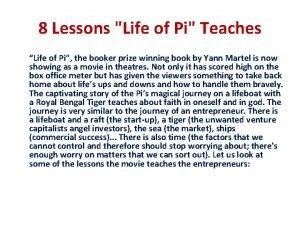www enthusiasticlife net Dr Anneenthusiastic Life Dr Margi



















- Slides: 19

www. enthusiasticlife. net Dr. Anneenthusiastic. Life Dr Margi. Anne Isaia, MD MPH PCC SET Triangular Theory of Love PART 8

THE TRIANGULAR THEORY OF LOVE: INTIMACY, PASSION AND COMMITMENT Sternberg’s Triangular Theory of Love = the important dimensions of a healthy romantic relationship are intimacy, passion, and commitment. They represent the emotional, motivational and cognitive components of love relationships. Intimacy is the feeling of closeness, connectedness that one feels in a relationship. ITM MM CO CY A IM INT EN T Passion represents the drives that lead to romance, physical attraction and sexual activity. PASSION Commitment involves a decision to maintain that relationship.

THE TRIANGULAR THEORY OF LOVE AND ATTACHMENT STYLES Three types of attachment in infancy--secure, anxious, avoidant--may have important implications for relationships later in life. A body of research has found that attachment predicts successful and unsuccessful relationships. Secure attachment is associated with greater trust and commitment, greater intimacy, greater self-confidence, better communication skills, and greater willingness for selfdisclosure Anxious individuals engage in poorer coping techniques, perceive more conflict and escalation of conflict in their relationships on a daily basis Avoidant attachment is associated with being emotionally distant and distrusting the partner and being less satisfied with the relationship.

THE TRIANGULAR THEORY OF LOVE AND ATTACHMENT STYLES Intimacy and commitment are the paths through which secure attachment can lead to relationship satisfaction. Intimacy and commitment may be relatively stable components whereas passion is relatively unstable and can fluctuate unpredictably. Passion may play a larger role in short term relationships and may be more dependent on psycho physiological arousal than intimacy and commitment. Passion may be more related to the sexual-behavior system contributing to attraction, vitality and arousal within the relationship.

STERNBERG’S TRIANGULAR THEORY OF LOVE These three components are seen in various combinations to evidence different types of love. According to Sternberg, there are eight types of love formed through the various combinations of the three components of love. A relationship (whether romantic in nature, familial, or casual) may go through any or all of these classifications of love. In Sternberg's model, couples harmoniously complement each other if each person is equally matched in levels of passion, intimacy, and commitment. Relationships in which the couples are unequal in any component are largely incompatible.

NON-LOVE Non-love does not contain any component of love. Non-love does not contain intimacy, passion, or commitment Intimate partner violence (intimate terrorism) NON LOVE

LIKING Liking details a relationship based on intimacy, but not passion or commitment. The characteristic of Liking is having close, intimate friendships with no long-term commitment CY A IM INT LIKING

INFATUATION Infatuation is a relationship based on passion, with no intimacy or commitment. Infatuation is characterized by passionate attraction on sight. PASSION INFATUATE LOVE

EMPTY LOVE CO MM ITM EN T Empty Love is a relationship based on commitment, lacking any intimacy or passion. An example of Empty Love is a couple staying in a marriage or relationship for the "sake of the children“; Empty Love is characterized by a lack of emotional warmth or heat of passion, where partners tolerate each other because of a false sense of duty, obligation or fear of change… EMPTY LOVE

ROMANTIC LOVE Romantic Love is a relationship based on passion and intimacy; however, it lacks commitment. Romantic Love is characterized by a couple who are emotionally and physically drawn to one another without the commitment of a long-term relationship. Romantic lovers look at each other through "rose colored glasses" not seeing each other's flaws. CY A IM INT PASSION ROMANTIC LOVE

COMPANIONATE LOVE ITM MM CO CY A IM INT EN T Companionate Love is based on intimacy and commitment without the wild fire of passion. Companionate Love is characterized by a committed friendship and shared intimacy; An example of Companionate Love is a marriage whose passion has dwindled. COMPANIONATE LOVE

FATUOUS LOVE Fatuous Love is based on passion and commitment, but lacks intimacy. Passion and commitment are combined before true intimacy can develop. CO MM ITM EN T Example: it could be a marriage commitment based on passionate sex which over times loses its passionate nature, and since the couple do not share intimate conversations, goals, and dreams, the marriage is ended when it is realized the couple are not a good match. PASSION FATUOUS LOVE

CONSUMMATE LOVE ITM MM CO CY A IM INT EN T Consummate Love involves intimacy, commitment, and passion. It is a complete Love when the partners are perfectly matched in passion, intimacy, and commitment. It is the ideal that most people try to achieve. PASSION CONSUMMATE LOVE

PATRIARCHAL GENDER RULES – PATRIARCHAL RULES FOR MEN Rule 1: Don’t act like girl Rule 2: Keep your feelings to yourself (showing anger is acceptable). Rule 3: Work is your first priority. Rule 4: Be self-reliant. Rule 5: Solve problems using aggression. Rule 6: Be dominant. Rule 7: Women are for sex. Rule 8: Don’t be gay (and avoid emotional closeness with other men). Care sunt rezultatele?

PATRIARCHAL GENDER RULES – CULTURE-BEARING RULES FOR WOMEN Rule 1: Perform but also minimize the value of “women’s work” and other human activities and traits traditionally deemed feminine. Rule 2: Read, predict, and manage the feelings and desires of boys and men. Rule 3: Support men’s preoccupation with work by sacrificing your own goals and dreams if necessary. Rule 4: Support the illusion of men’s self-reliance while fashioning the illusion of women’s dependency. Rule 5: Accept men’s aggression, and go along with the story that men’s aggression protects families. Rule 6: Be submissive. Accept that the head of the household (or other social organization) should rightfully be male. Rule 7: Accept and promote sexual objectification of females. Rule 8: Promote homophobia. Care sunt rezultatele?

PARTNERSHIP CODE Rule 1: Nurture one another, and share family care giving activities such as child care. Rule 2: Express and accept the expression of the full spectrum of feelings, not just anger. Offer emotional openness and vulnerability. Rule 3: Life is your first priority. Balance work against relationship priorities. Rule 4: Collaborate. Recognize the limits of self-reliance and the value of interdependence. Rule 5: Solve problems using negotiation rather than aggression. Rule 6: Share leadership. Rule 7: Always recognize the humanity in your partner rather than objectifying them. Rule 8: Value queer people and people across all dimensions of diversity. Work to replace bias with social justice.

CLASSICAL AUTHOR “God wants the home to be the happiest place on earth, the very symbol of the home in heaven. Bearing the marriage responsibilities in the home, linking their interests with Jesus Christ, leaning upon His arm and His assurance, husband wife may share happiness in this union that angels of God commend. EGW AH 102. 2

FAMILY REFLECTION How satisfied are you with this relationship? How easy is it for you to talk to your partner about important issues? How easy is it for you to talk to your partner about everyday issues? How satisfied are you with the intimacy of your relationship? How much do you think you are in a passionate relationship? How much do you think you are in a committed relationship? How much do you think your partner is committed to the relationship? How likely do you think you will be in this relationship one year from now? How much do you rely on your partner for stability in this relationship? How easy was it for you to begin this relationship?

REFERENCES Madey, S. , F & Rodgers, L. , The Effect of Attachment and Sternberg’s Triangular Theory of Love on Relationship Satisfaction, Individual Differences Research 2009, Vol. 7, No. 2, pp. 76 -84 Hasserbrauck, M. , Three-Dimensional Love, The Journal of Social Psychology, 1996, 131 (1), 121 -122 Almeida, R. V. , Dolan-Del Vecchio, K. , Parker, L. , Transformative Family Therapy, Just Families in a Just Society (2008) Nevid, J. S. , & Rathus, S. A. Psychology and the challenges of life: Adjustment in the new millennium 9 th edition (2005)
 Dr margi
Dr margi Family circumplex model
Family circumplex model Dr margi
Dr margi Achmed lach net ich krieg mein tach net
Achmed lach net ich krieg mein tach net Ado.net vb.net
Ado.net vb.net Vb.net end of life
Vb.net end of life City and country life vocabulary
City and country life vocabulary City life vs country life
City life vs country life Polynomial functions used in real life
Polynomial functions used in real life Single life vs married life debate
Single life vs married life debate Difference between life skills and life orientation
Difference between life skills and life orientation Country life vs city life compare /contrast
Country life vs city life compare /contrast City life vs country life
City life vs country life Life of pi moral lesson
Life of pi moral lesson Boundaries meme
Boundaries meme Life that is truly life
Life that is truly life The idea life comes from life is
The idea life comes from life is Freetutorical.com harvest land
Freetutorical.com harvest land Etwinning sohbet odası
Etwinning sohbet odası Thearbiter.net
Thearbiter.net





































